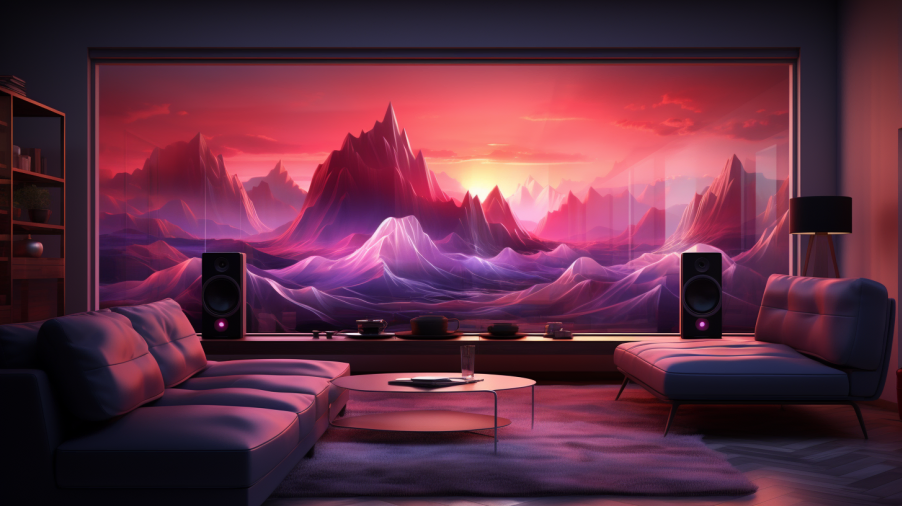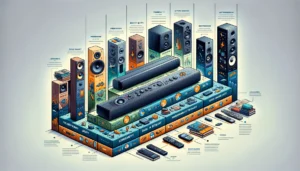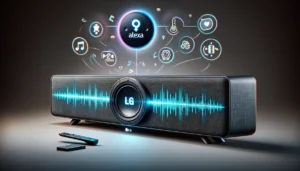You settle into the couch, popcorn in hand, ready for movie night. But as action erupts onscreen, you notice something missing – the sounds lack impact and immersion.
The TV’s puny built-in speakers fail to deliver engaging surround audio. There must be a better way to get spatial sound without all the complexity of a home theater setup.
Soundbars with surround sound capabilities can bring a taste of cinematic audio immersion into your living room without requiring a dedicated multi-speaker installation.
Modern virtual processing approximates the engulfing experience of surround formats like Dolby Atmos surprisingly well.
And with the right budget-friendly soundbar solution, you can elevate your TV viewing from flat and lifeless to thrilling and multidimensional.
Let’s dive in and examine exactly how surround sound works and why it’s so desirable compared to standard stereo playback.
How Surround Sound Works And Why It’s Desirable

Surround sound utilizes multiple speakers strategically placed around the listener to envelop you in audio coming from all directions, creating a 360-degree sound field.
The most common surround format is 5.1, which refers to five full-range speakers (left, center, right, rear left, rear right) plus a subwoofer (.1) for deep bass effects.
Having discrete audio channels surrounding you makes you feel like you’re right in the middle of the action – whether it’s a plane flying overhead in a movie or enemy gunfire in a video game.
Surround sound gives sound dimension and space, with audio effects panning smoothly from front to back based on what’s happening on screen.
This provides a much more natural, immersive, and lifelike listening experience compared to standard stereo from just left and right speakers.
Surround engages your senses, creating an auditory experience closer to real life where sounds originate from all around us.
Our brains are wired to locate sounds in 3D space, so surround sound feels more natural and instinctive.
Explosions resonate all around you, the dialogue seems to come directly from characters on screen, and ambient effects like rain envelop you from all angles.
This level of immersion isn’t possible with stereo as audio lacks dimensionality. True surround sound is a must for the most lifelike and spatial listening experience.
It’s why home theaters utilize multiple speakers – no other setup can provide the same engulfing experience.
Can Soundbars Create Surround Effects? Pros And Cons.

While a single soundbar can’t match the experience of having actual speakers surrounding you, modern soundbars employ some clever processing tricks to approximate the effects of surround sound.
Soundbars contain multiple angled drivers firing in different directions.
When fed a surround soundtrack, advanced digital signal processing bounces audio around the drivers to create a 3D soundscape with the illusion of discrete channels.
This “virtual surround” effect from a soundbar works decently well, using psychoacoustics to trick your brain into hearing sounds from locations where no physical speakers exist.
Some soundbars include wireless surround speakers, allowing you to place real rear channels behind you for true 5.1 surround effects.
Soundbars provide an easy way to add surround dimensionality in smaller rooms where installing in-wall/ceiling speakers isn’t feasible.
However, virtual surround from a soundbar lacks precision, often sounding diffuse without clearly defined rear channels.
Processing can’t replicate the well-defined directional effects of discrete surround channels. Surround imaging isn’t as sharp.
Without physical speakers surrounding you, the soundfield lacks depth and true dimensionality.
Virtual effects sound “inside your head” rather than fully enveloping. Wireless surround speakers raise costs, requiring multiple components instead of an all-in-one solution.
Overall, while soundbars can add a sense of immersion beyond stereo, they can’t match the lifelike bubble of a dedicated surround system. Manage expectations when using soundbars for surround effects.
Soundfield Processing Like Dolby Atmos Explained

In addition to virtual surround, new soundfield processing technologies like Dolby Atmos aim to boost immersion from soundbars. Here’s how they work: Atmos doesn’t rely on fixed surround channels.
Instead, it uses dynamic object-based audio with sounds positioned anywhere in 3D space. Special height/overhead channels place audio above you, in addition to surround coverage. This adds another dimension to immersion.
Atmos-enabled soundbars employ upward-firing drivers that bounce sound off the ceiling to create the illusion of overhead audio.
Soundfield processing analyzes objects’ onscreen positions then maps their location to available speakers.
DTS:X is a competing format to Atmos that similarly achieves 3D audio using soundfield manipulation. Benefits of Atmos/DTS:X: Make overhead effects like rain, aircraft, etc sound above you, increasing realism.
Widen the surround soundstage versus limited horizontal-only effects. Adds a sense of verticality and air to audio that standard 5.1 can’t match. Works decently well despite limited speaker channels thanks to processing.
Limitations: Onboard processing struggles to precisely place certain effects, reducing accuracy. Lacks the complete overhead sound dome that in-ceiling Atmos speakers provide.
Still confined to soundbar’s physical driver locations unlike proper object-based setups. In summary, Atmos and DTS:X allow more advanced surround capabilities from soundbars.
While not perfect, they add dimensionality over standard virtual surround. An affordable way to improve immersion.
Models With Wireless Rears For Surround Sound

Higher-end soundbars aimed at home theater enthusiasts often include the option of adding separate wireless surround speakers. This provides an easy way to get truly immersive rear channel effects that virtual processing alone can’t match.
Popular models like the Sonos Arc and Bose Smart Soundbar 900 offer wireless “satellite” speakers. These surrounds are placed behind the listening position and sync wirelessly with the soundbar.
The soundbar decodes surround audio then transmits discrete channels to the rears (i.e. rear left/right). This creates a system akin to 5.1 surround with proper directional sounds, precision panning, and an enveloping bubble of audio around you.
Wireless rears are convenient for cluttered living spaces since you don’t need to run speaker wires to rear locations. However, wireless surround bundles are pricier than a soundbar alone. You pay for the additional rear speakers.
There’s added setup complexity over soundbars with virtual processing built-in. Wireless connectivity means potential for latency and sync issues.
That said, wireless surround speakers provide the most convenient and hassle-free way to achieve true directional multichannel audio from a soundbar-based system. For purists who want proper rear channel separation without installing in-wall surrounds, wireless rears are likely worth the premium. It’s the closest you can get to a true surround system without the complexity.
Virtual Surround Effects From A Single Bar

Many standalone soundbars rely on complex psychoacoustic processing to mimic a surround experience using just their built-in speaker drivers. Single soundbars typically have angled left, center, and right drivers.
Some include side-firing drivers for added width. When playing surround content, advanced DSP creates phantom rear channel effects using just the physical drivers present.
Processing applies carefully tuned delays and phase shifts to trick your brain into thinking sound is coming from behind. Most aim to create the surround impressions matching a typical 5.1 system (left, center, right, rears).
Budget models from companies like Vizio, Samsung, employ virtual surround to expand the listening space. How well does virtual surround work? It depends greatly on the sophistication of a soundbar’s processing and number of drivers.
Entry-level models struggle to convince your ears that distinct rear effects exist, often sounding gimmicky. Some premium bars prove moderately convincing, adding reasonable surround dimensionality. But quality varies widely across brands.
Virtual surround can help expand the perceived soundstage for casual TV/music listening. But generally isn’t sufficient for serious movie watching compared to real surround channels.
While innovations in DSP make virtualized effects marginally better over time, true wireless rear speakers or additional surround components remain the best way to achieve satisfying directional audio from a soundbar. For most, virtual surround is a helpful effect but no complete replacement for the real thing.
Real Surround Vs. Virtual Surround Comparison

Direct A/B listening reveals noticeable differences in surround effects between dedicated discrete channels and virtualized psychoacoustics. Real surround with physical speakers provides precise directional channels seamlessly panning from front to back.
Excellent left-right and front-rear separation. Rear effects sound spatially distinct rather than blending together. Life-like ambience truly envelops the listener with natural immersion.
Localization remains consistent as you move around the room. Sounds snap to fixed locations. Capable of high volumes and dynamic pans using discrete amplifier power.
In contrast, virtual surround processing lacks precision, with amorphous rear channel effects bleeding into the front stage. No distinct separation. Rear sounds are vague rather than well-defined directional effects.
Ambience doesn’t fully envelope you, often sounding “inside your head.” Surround effects seem to move wildly as you shift positions, lacking stability.
Dynamics limited since all sound originates from a single bar. Struggles conveying impact. The bottom line is only real physical surrounds can provide the complete bubble of immersion and lifelike directional audio that surround sound promises. While innovations in virtual processing continue, there’s no replacement for dedicated speakers surrounding the listener.
Budget Options For Basic Surround Effects

You don’t necessarily need to spend thousands on an elaborate surround system to enjoy at least a taste of immersion at home. Entry-level virtual surround soundbars under $300 from Vizio, TCL, Yamaha feature built-in virtual surround modes.
Don’t expect miracles at this price, but they may offer a sense of expanded space. Worth trying. Some soundbars can be paired with cheap wireless satellite speakers for ~$100-150.
For example, Vizio’s entry-level models support surround speaker add-ons. This provides basic but true directional rear effects for an affordable upcharge.
Additionally, check resale sites for 5.1 home theater in a box bundles 10+ years old. Sound quality is dated, but gives a feel for proper surround at low cost. Lets you test surround benefits before investing in modern equipment.
The bottom line is with reasonable expectations, you can start to experience surround’s spatial benefits even on a tight budget. While flagship systems remain ideal, a frugal surround setup can still dramatically improve entertainment immersion compared to plain stereo.
Conclusion
Ultimately, surround sound delivers an engulfing audio experience that stereo simply can’t match. While dedicated surround speaker setups remain the gold standard, modern soundbars employ clever psychoacoustics and processing to approximate immersive effects.
For compact living spaces, soundbars make surround audio more accessible and convenient. Models with wireless rears provide the most realistic effects for discerning surround fans.
Even basic virtual modes can add a taste of dimensionality. With the right soundbar and calibrated expectations, you can enjoy impactful, cinematic audio without the complexity of a full home theater installation.
Surround sound enlivens movies, games, and music with added depth. Before upgrading your flat panel TV, consider complementing it with a capable soundbar that takes your entertainment into the third dimension.



